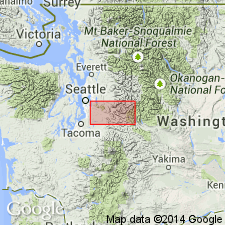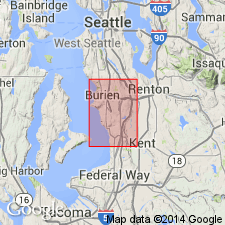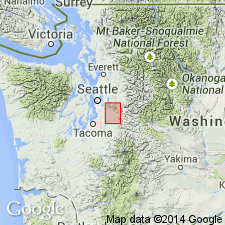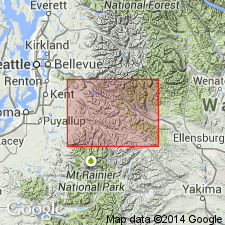
- Usage in publication:
-
- Renton Formation*
- Modifications:
-
- Areal extent
- Biostratigraphic dating
- AAPG geologic province:
-
- Puget Sound province
Summary:
South of Taylor Mountain, 15 mi east of Renton in central King co, WA, formation consists of 2250 ft of feldspathic micaceous fine- to medium-grained sandstone, interbedded in upper part with beds of coal, carbonaceous siltstone, and claystone. Overlies Tukwila Formation; top not exposed. Fossil leaves, studied by Jack Wolfe, indicate lower part of Renton is at least locally equivalent in age to upper part of Tukwila Formation. Renton is considered to be late Eocene and earliest Oligocene age.
Source: GNU records (USGS DDS-6; Menlo GNULEX).

- Usage in publication:
-
- Renton formation*
- Modifications:
-
- Named
- Dominant lithology:
-
- Sandstone
- Arkose
- Shale
- Coal
- AAPG geologic province:
-
- Puget Sound province
Summary:
Named for city of Renton in western King Co, WA, where formation typically exposed [type locality] in S/2 sec.17, SW/4 sec.18 and E/2 sec.19 T23N R5E, Des Moines 7.5' quad. Also well exposed along highway 5-M in secs.14 and 23 T23N R5E. Is chiefly fine- to medium-grained arkosic and feldspathic sandstone with lesser amounts of sandy shale, siltstone, coal, and carbonaceous shale. Thickness is probably more than 4000 ft; top not exposed. Conformably overlies Tukwila Formation (new) of Puget Group. Formation includes Renton coal measures which were extensively mined at and near Renton in early part of century. No fossils were found. Plant fossils in underlying Tukwila Formation represent last half of Eocene epoch, according to R.W. Brown.
Source: GNU records (USGS DDS-6; Menlo GNULEX).

- Usage in publication:
-
- Renton Formation*
- Modifications:
-
- Geochronologic dating
- Areal extent
- AAPG geologic province:
-
- Puget Sound province
Summary:
Small-scale map shows formation extends from type area northward 6 mi to Newcastle and eastward 15 mi to south side of Taylor Mountain. Puget Group, undivided, which includes nonmarine rocks equivalent in age to Renton Formation, extends many mi farther south. Authors cite considerable inconsistency between radiometric age of flora of a given stage and age of a similar flora from type section. Renton and Tukwila Formations are both considered middle and late Eocene age. Marine foraminifers from volcanicalstic rocks that conformably overlie Renton northwest of Tiger Mountain are Oligocene age.
Source: GNU records (USGS DDS-6; Menlo GNULEX).

- Usage in publication:
-
- Renton Formation*
- Modifications:
-
- Areal extent
- AAPG geologic province:
-
- Puget Sound province
Summary:
Renton Formation is geographically extended into the report area. Age is middle and late Eocene.
Source: GNU records (USGS DDS-6; Menlo GNULEX).
For more information, please contact Nancy Stamm, Geologic Names Committee Secretary.
Asterisk (*) indicates published by U.S. Geological Survey authors.
"No current usage" (†) implies that a name has been abandoned or has fallen into disuse. Former usage and, if known, replacement name given in parentheses ( ).
Slash (/) indicates name conflicts with nomenclatural guidelines (CSN, 1933; ACSN, 1961, 1970; NACSN, 1983, 2005, 2021). May be explained within brackets ([ ]).

